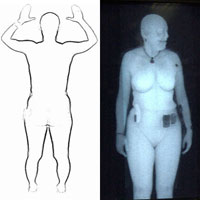在机场安检的时候,你是愿意被“搜身”呢还是用扫描检查?大部分人都会选择扫描检查,他们觉得“搜身”侵犯了个人隐私。但是扫描检查用的可是X射线,那么,这种扫描检查会对身体有害吗?

This is the technology that caused a privacy uproar when it was first revealed as a possible addition to airport security. The backscatter X-ray scanner sees through clothes and is capable of producing photo-quality views of its subject. So in theory, passengers selected for additional screening with the backscatter system could be subjecting themselves to a peep show by airport employees.
The backscatter system works differently than the usual X-ray scanners that check out your carry-on luggage.
The X-ray scanners we send our carry-on bags through are usually dual-energy X-ray systems. In this type of system, the X-ray source sends out a single X-ray beam. Different types of materials -- organic, inorganic and metallic, for instance -- react differently to X-rays, which are basically very high-energy light photons. Depending on the density and atomic properties of an object, it may absorb X-rays, let X-rays pass right through or scatter the X-rays on impact. Organic material, like skin, bananas and liquid explosives, tend to let X-rays pass through them. In a dual-energy system, after the X-rays interact with the objects in your carry-on bag, they reach three barriers: a detector that picks up the pattern created by both high- and low-energy absorption and pass-through; a filter that then removes the lower-energy X-rays; and then a high-energy detector, which picks up the pattern of the high-energy X-ray absorption and pass-through. A computer program then compares the images from the two detectors in order to provide a very clear, color-coded image of the different types of materials in your bag. It's the comparison of the first detector's image with the last detector's image that highlights the "low-energy objects" -- mostly the organic stuff -- in the bag.
The other issue besides privacy that has surrounded backscatter X-raying has to do with radiation exposure. Most of us do not get X-rayed on a regular basis; and when we do get X-rayed in a hospital or doctor's office, we've got a lead vest thrown over our vital organs. But at airports, there's no lead vest. So are people who travel a lot going to be subjected to dangerous levels of radiation if they get backscattered too often? Most experts say no. According to the Health Physics Society (HPS), a person undergoing a backscatter scan receives approximately 0.005 millirems (mrem, a unit of absorbed radiation). American Science and Engineering, Inc., actually puts that number slightly higher, in the area of .009 mrem. According to US regulatory agencies, 1 mrem per year is a negligible dose of radiation, and 25 mrem per year from a single source is the upper limit of safe radiation exposure. Using the HPS numbers, it would take 200 backscatter scans in a year to reach a negligible dose -- 1 mrem -- of radiation. You receive 1 mrem from three hours on an airplane, from two days in Denver or from three days in Atlanta. And it would take 5,000 scans in a year to reach the upper limit of safety. A traveler would have to get 100 backscatter scans per week, every week, for a year, in order to be in real danger from the radiation. Few frequent flyers fly that frequently.
(来源:howstffworks网站 实习生许雅宁 英语点津 Annabel 编辑)
我要了解更多趣味百科知识